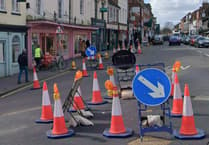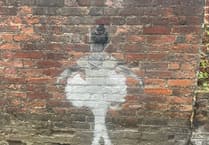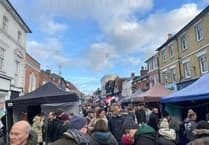Following the appearance of Paul Rollinson’s postcard of the Cambridge House girls’ school in West Street, Farnham, Pat Seale has once again taken up the challenge of finding out a little bit more about the school, the people who ran it and some of their pupils.
“The principal of the school was Mr William Penn (1839-1908),” she writes. “In 1911 the school was run by his widow, Elizabeth, assisted by step-daughters Clara, 41, and Victoria, 29.
“The word ‘step-daughters’, and the ages of the daughters are the clues that Elizabeth was his second wife. They had been married 27 years.
“There were three other teachers, a pupil teacher and three servants. There were four pupils boarding on census night (April 2), but this may not have been typical ahead of Easter (April 16), or simply that the majority were day pupils.
“Looking in the 1901 census, William and Elizabeth Penn were running the school in East Street. The enumerator visited No7, home of John Thomas Patterson, bootmaker, then came ‘Eastholme House’, home to the school, presumably No8. After that came No9 East Street, home to Samuel and Elizabeth Bates, grocers.
“The date of the photo of Cambridge House would be after 1901, likely before or around 1911 and certainly before 1916, and the name on the board could be either ‘Mr’ or ‘Mrs’ William Penn.
“Jonathan Wood, in his book A Portrait of Farnham says: ‘Entrance to the [Cambridge Place] shops was once the ground floor of 8 East Street... in 1878 the home of Miss Louisa Stratford’s Ladies’ Boarding School. The radical surgery was required to provide pedestrian access to The Electric Cinema....’
“In 1901 William and Elizabeth described themselves as principal and co-principal of the school. Daughter Clara was headmistress, daughter Hilda, 23, taught the kindergarten, and daughter Dorothy, 19, taught the junior form. They employed three servants. There were more members of staff at No10 East Street, with five pupil boarders.
“One name stood out: Mabel Osgood, 14. It’s a case of how small the world is: I have been sifting through an amazing collection of Cartes de Visite and cabinet cards most of the summer, and... there’s a photo of Mabel Osgood with her two older sisters.
“We learn from this that the Penns’ clientèle included the daughter of a farmer. In 1901 Thomas Osgood (1855-1950) was living at Shawfield Farm in Ash and was an employer. Mabel went on to become a governess and was working in a preparatory school in Cheltenham in 1911.
“Continuing back in time, in 1891 William and Elizabeth (née Chaplin) were running a school on the Isle of Wight. They had married in 1884 in Hackney, two years after the death of William’s first wife Elizabeth (née Hewitt), at the young age of 35. William and the first Elizabeth had married in 1867, and it seems William wasn’t a teacher by training: in 1871 William was a clerk, in 1881 a private tutor, so an unusual route to the position of principal of a school.
“And after the 1911 census? It’s likely the school came to a close in the years following. Elizabeth (Chaplin) died in 1916, age 71, and she was by then living in the Strawberry Hill area of Middlesex. Later records indicate the family dispersed. William’s two sons went to the USA, daughter Lizzie married and emigrated to Canada and the other daughters lived in different parts of the UK.”
Another amazing bit of research I am sure you will agree, and much of it backed by others who commented via our Facebook page.
Andrew G Doe writes: “In 1889, Mr and Mrs William Penn advertised their Farnham High School for Girls, which became Cambridge House Private School for Girls in 1910, run by Mrs W Penn and Miss Clara Mabel Penn.”
Elizabeth Mills has more about the Isle of Wight connection and William Penn’s earlier life: “At the time of the 1891 census, William Penn was a schoolmaster at High Park Hall, St Helens, Isle of Wight. In 1881 he is listed as a private tutor in West Hackney. In 1871 he was a clerk living in Islington. Elizabeth Penn was born Elizabeth Chaplin and was William’s second wife; his first was Elizabeth Hindley Hewitt who had died in 1884 leaving William with seven children, the youngest of whom was only three.”
I find it quite incredible how Peeps readers pick up the simplest of items from the column and always manage to reveal the hidden stories.
Thank you all very much – without the dedication of our readers this column would be far less interesting.





Comments
This article has no comments yet. Be the first to leave a comment.